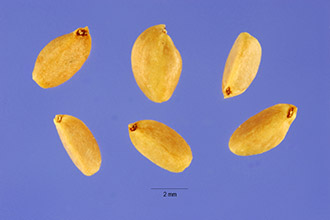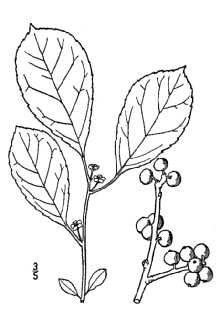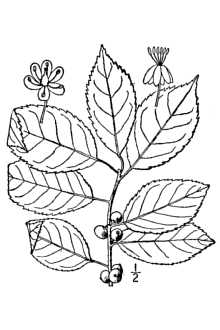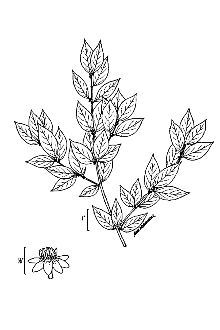Ilex fastigiata E.P. Bicknell
Scientific Name: Ilex fastigiata E.P. Bicknell
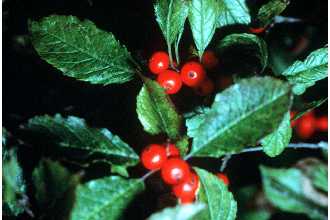
| General Information | |
|---|---|
| Usda Symbol | ILFA |
| Group | Dicot |
| Life Cycle | Perennial |
| Growth Habits | ShrubTree, |
| Native Locations | ILFA |
Plant Guide
Use a soil moisture meter to monitor the soil moisture where Ilex fastigiata E.P. Bicknell is planted.
Fact Sheet
Uses
The attractive bright red fruit of winterberry is eaten by small mammals and more than 48 species of birds. The leaves and stems of winterberry are not a preferred source of browse, but moose, whitetail deer, cottontail rabbits, and snowshoe hare do utilize this plant. The persistent bright red fruit of this shrub make it very popular for landscaping. It is recommended for planting in shady moist areas, even though its growth and form are best under open grown conditions.
Status
Please consult the PLANTS Web site and your State Department of Natural Resources for this plant’s current status (e.g. threatened or endangered species, state noxious status, and wetland indicator values).
Description
Winterberry is an erect moderate sized shrub, growing to heights of 5 to 15 feet tall. The smooth bark of winterberry is gray to blackish, with knobby lenticels The dense branches of this shrub grow in a zigzag pattern with an upright spreading crown. The twigs are slender, with gray to gray-brown color and small buds. The simple, smooth, obovate to oblong-ovate foliage is sharply double toothed, with medium fine texture. The deciduous leaves are arranged alternately along the stems. Each leaf is 1 1/2 to 4 inches long, with dark green summer color turning yellow in fall, then drop off by mid-October. Small, inconspicuous, axillary, greenish to yellowish-white flowers bloom from April to July, after leaves have emerged. Like most others in the holly genus, winterberry is dioecious. Three years after planting, pistillate flowers begin to emerge in small clusters plants and staminate flowers develop on male plants with up to twelve flowers in a cluster; only now can plant gender be determined. Scarlet red to orange, globular fruit mature by late summer, often remaining on the plant into mid-winter. The berry-like fruit is about 1/4 inch in diameter, occurring singlely or in pairs, each containing 3 to 5 small nutlets. There are an average of 92,000 seeds per pound. Robert H. Mohlenbrock USDA NRCS 1989 Midwestern Wetland Flora @ USDA NRCS PLANTS
Adaptation and Distribution
Distribution
Distribution
Winterberry is found throughout the eastern United States, Use soil moisture sensors to measure the soil moisture of Ilex fastigiata E.P. Bicknell., For a current distribution map, please consult the Plant Profile page for this species on the PLANTS Website,
Establishment
Planting units of winterberry are propagated by seed, rooted stem divisions, and stem cuttings alike. The germination is usually hindered by hard seed coats and embryo dormancy. Utilizing proper after ripening and cold moist stratification procedures, germination can be stimulated. Seed should be covered with at least 1/8 to 1/2 inch of soil on nursery beds. Fall seedings should be mulched for winter protection. When seedlings are acquired, the sex of the plant is typically indeterminable, in contrast to those propagated vegetatively. In late fall root suckers can be directly dug and transplanted, while actively growing softwood cuttings are taken from late spring to mid-summer. The cuttings are first placed under glass or plastic, but once roots form and begin to grow, they can be transplanted into containers or nursery beds for further development. Utilize standard tree and shrub planting procedures to plant bare rooted transplants, containerized, or balled and burlapped stock.
Plant Traits
Growth Requirements
| Cold Stratification Required | Yes |
|---|---|
| Hedge Tolerance | Low |
| Hedge Tolerance | Low |
| Frost Free Days, Minimum | 140 |
| Frost Free Days, Minimum | 140 |
| Fire Tolerance | Low |
| Fire Tolerance | Low |
| Fertility Requirement | Medium |
| Fertility Requirement | Medium |
| Drought Tolerance | Low |
| Drought Tolerance | Low |
| Cold Stratification Required | Yes |
| Temperature, Minimum (°F) | -33 |
| CaCO3 Tolerance | Low |
| CaCO3 Tolerance | Low |
| Anaerobic Tolerance | Low |
| Anaerobic Tolerance | Low |
| Adapted to Medium Textured Soils | Yes |
| Adapted to Medium Textured Soils | Yes |
| Adapted to Fine Textured Soils | Yes |
| Adapted to Fine Textured Soils | Yes |
| Adapted to Coarse Textured Soils | No |
| Adapted to Coarse Textured Soils | No |
| Moisture Use | High |
| Temperature, Minimum (°F) | -28 |
| Shade Tolerance | Intermediate |
| Shade Tolerance | Intermediate |
| Salinity Tolerance | None |
| Salinity Tolerance | None |
| Root Depth, Minimum (inches) | 16 |
| Root Depth, Minimum (inches) | 16 |
| Precipitation, Minimum | 35 |
| Precipitation, Minimum | 35 |
| Precipitation, Maximum | 60 |
| Precipitation, Maximum | 60 |
| Planting Density per Acre, Minim | 700 |
| Planting Density per Acre, Minim | 700 |
| Planting Density per Acre, Maxim | 2700 |
| Planting Density per Acre, Maxim | 2700 |
| pH, Minimum | 4.5 |
| pH, Minimum | 4.5 |
| pH, Maximum | 7.5 |
| pH, Maximum | 7.5 |
| Moisture Use | High |
Morphology/Physiology
| Active Growth Period | Spring and Summer |
|---|---|
| Toxicity | None |
| Toxicity | None |
| Shape and Orientation | Climbing |
| Fire Resistant | No |
| Foliage Texture | Coarse |
| Foliage Texture | Coarse |
| Foliage Porosity Winter | Moderate |
| Foliage Porosity Winter | Moderate |
| Foliage Porosity Summer | Dense |
| Foliage Porosity Summer | Dense |
| Foliage Color | Green |
| Foliage Color | Green |
| Flower Conspicuous | No |
| Flower Conspicuous | No |
| Flower Color | White |
| Flower Color | White |
| Resprout Ability | Yes |
| Fire Resistant | No |
| Fall Conspicuous | Yes |
| Fall Conspicuous | Yes |
| Coppice Potential | No |
| Coppice Potential | No |
| C:N Ratio | High |
| C:N Ratio | High |
| Bloat | None |
| Bloat | None |
| Active Growth Period | Spring and Summer |
| Shape and Orientation | Climbing |
| Fruit/Seed Color | Red |
| Resprout Ability | Yes |
| Nitrogen Fixation | None |
| Nitrogen Fixation | None |
| Low Growing Grass | No |
| Low Growing Grass | No |
| Lifespan | Moderate |
| Lifespan | Moderate |
| Leaf Retention | No |
| Leaf Retention | No |
| Known Allelopath | No |
| Known Allelopath | No |
| Height, Mature (feet) | 10.0 |
| Height, Mature (feet) | 9.0 |
| Fruit/Seed Color | Red |
| Fruit/Seed Conspicuous | Yes |
| Fruit/Seed Conspicuous | Yes |
| Growth Form | Multiple Stem |
| Growth Form | Multiple Stem |
| Growth Rate | Moderate |
| Growth Rate | Moderate |
| Height at 20 Years, Maximum (fee | 6 |
| Height at 20 Years, Maximum (fee | 6 |
Reproduction
| Propagated by Cuttings | Yes |
|---|---|
| Propagated by Seed | Yes |
| Propagated by Seed | Yes |
| Propagated by Sod | No |
| Propagated by Sod | No |
| Propagated by Sprigs | No |
| Propagated by Sprigs | No |
| Propagated by Tubers | No |
| Propagated by Tubers | No |
| Seed per Pound | 92000 |
| Fruit/Seed Period End | Fall |
| Seed per Pound | 92000 |
| Seed Spread Rate | Slow |
| Seed Spread Rate | Slow |
| Seedling Vigor | Low |
| Seedling Vigor | Low |
| Small Grain | No |
| Small Grain | No |
| Vegetative Spread Rate | None |
| Vegetative Spread Rate | None |
| Propagated by Corm | No |
| Propagated by Cuttings | No |
| Bloom Period | Late Spring |
| Bloom Period | Late Spring |
| Commercial Availability | Routinely Available |
| Commercial Availability | Routinely Available |
| Fruit/Seed Abundance | High |
| Fruit/Seed Abundance | High |
| Fruit/Seed Period Begin | Summer |
| Fruit/Seed Period Begin | Summer |
| Fruit/Seed Period End | Fall |
| Fruit/Seed Persistence | Yes |
| Propagated by Bare Root | Yes |
| Propagated by Bare Root | Yes |
| Propagated by Bulb | No |
| Propagated by Bulb | No |
| Propagated by Container | Yes |
| Propagated by Container | Yes |
| Propagated by Corm | No |
| Fruit/Seed Persistence | Yes |
Suitability/Use
| Palatable Browse Animal | Low |
|---|---|
| Palatable Graze Animal | Low |
| Palatable Graze Animal | Low |
| Palatable Human | No |
| Palatable Human | No |
| Post Product | No |
| Post Product | No |
| Protein Potential | Low |
| Protein Potential | Low |
| Pulpwood Product | No |
| Pulpwood Product | No |
| Veneer Product | No |
| Veneer Product | No |
| Palatable Browse Animal | Low |
| Nursery Stock Product | Yes |
| Nursery Stock Product | Yes |
| Naval Store Product | No |
| Naval Store Product | No |
| Lumber Product | No |
| Lumber Product | No |
| Fodder Product | No |
| Fodder Product | No |
| Christmas Tree Product | No |
| Christmas Tree Product | No |
| Berry/Nut/Seed Product | No |
| Berry/Nut/Seed Product | No |

